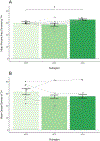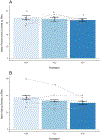Immunolabeling Provides Evidence for Subregions in the Songbird Nucleus Accumbens and Suggests a Context-Dependent Role in Song in Male European Starlings (Sturnus vulgaris)
- PMID: 34879382
- PMCID: PMC8930704
- DOI: 10.1159/000521310
Immunolabeling Provides Evidence for Subregions in the Songbird Nucleus Accumbens and Suggests a Context-Dependent Role in Song in Male European Starlings (Sturnus vulgaris)
Abstract
Birdsong is well known for its role in mate attraction during the breeding season. However, many birds, including European starlings (Sturnus vulgaris), also sing outside the breeding season as part of large flocks. Song in a breeding context can be extrinsically rewarded by mate attraction; however, song in nonbreeding flocks, referred to here as gregarious song, results in no obvious extrinsic reward and is proposed to be intrinsically rewarded. The nucleus accumbens (NAC) is a brain region well known to mediate reward and motivation, which suggests it is an ideal candidate to regulate reward associated with gregarious song. The goal of this study was to provide new histochemical information on the songbird NAC and its subregions (rostral pole, core, and shell) and to begin to determine subregion-specific contributions to gregarious song in male starlings. We examined immunolabeling for tyrosine hydroxylase (TH), neurotensin, and enkephalin (ENK) in the NAC. We then examined the extent to which gregarious and sexually motivated song differentially correlated with immunolabeling for the immediate early genes FOS and ZENK in each subdivision of the NAC. We found that TH and ENK labeling within subregions of the starling NAC was generally similar to patterns seen in the core and shell of NACs in mammals and birds. Additionally, we found that gregarious song, but not sexually motivated song, positively correlated with FOS in all NAC subregions. Our observations provide further evidence for distinct subregions within the songbird NAC and suggest the NAC may play an important role in regulating gregarious song in songbirds.
Keywords: Communication; Dopamine; Immediate early genes; Nucleus accumbens; Opioids; Reward; Songbird.
© 2021 S. Karger AG, Basel.
Conflict of interest statement
Conflict of Interest Statement
Authors report no conflict of interest.
Figures









Similar articles
-
Birdsong and the Neural Regulation of Positive Emotion.Front Psychol. 2022 Jun 22;13:903857. doi: 10.3389/fpsyg.2022.903857. eCollection 2022. Front Psychol. 2022. PMID: 35814050 Free PMC article. Review.
-
Neurotensin immunolabeling relates to sexually-motivated song and other social behaviors in male European starlings (Sturnus vulgaris).Behav Brain Res. 2015 Apr 1;282:133-43. doi: 10.1016/j.bbr.2015.01.007. Epub 2015 Jan 13. Behav Brain Res. 2015. PMID: 25595421 Free PMC article.
-
Co-localization patterns of neurotensin receptor 1 and tyrosine hydroxylase in brain regions involved in motivation and social behavior in male European starlings.J Chem Neuroanat. 2018 Apr;89:1-10. doi: 10.1016/j.jchemneu.2018.01.002. Epub 2018 Jan 31. J Chem Neuroanat. 2018. PMID: 29407461 Free PMC article.
-
ZENK labeling within social behavior brain regions reveals breeding context-dependent patterns of neural activity associated with song in male European starlings (Sturnus vulgaris).Behav Brain Res. 2007 Jan 25;176(2):333-43. doi: 10.1016/j.bbr.2006.10.023. Epub 2006 Nov 17. Behav Brain Res. 2007. PMID: 17113163 Free PMC article.
-
Evidence for opioid involvement in the motivation to sing.J Chem Neuroanat. 2010 Mar;39(2):141-50. doi: 10.1016/j.jchemneu.2009.03.008. Epub 2009 Apr 5. J Chem Neuroanat. 2010. PMID: 19995531 Free PMC article. Review.
Cited by
-
The Dorsal Part of the Anterior Tuberal Nucleus Responds to Auditory Stimulation in Zebrafish (Danio rerio).eNeuro. 2024 Jul 10;11(7):ENEURO.0062-24.2024. doi: 10.1523/ENEURO.0062-24.2024. Print 2024 Jul. eNeuro. 2024. PMID: 38918052 Free PMC article.
-
The motivation to flock correlates with vocal-social behaviors and dopamine-related gene expression in male European starlings.Horm Behav. 2023 Jul;153:105374. doi: 10.1016/j.yhbeh.2023.105374. Epub 2023 Jun 2. Horm Behav. 2023. PMID: 37271085 Free PMC article.
-
Mu opioid receptor stimulation in the medial preoptic area or nucleus accumbens facilitates song and reward in flocking European starlings.Front Physiol. 2022 Sep 12;13:970920. doi: 10.3389/fphys.2022.970920. eCollection 2022. Front Physiol. 2022. PMID: 36171974 Free PMC article.
-
Birdsong and the Neural Regulation of Positive Emotion.Front Psychol. 2022 Jun 22;13:903857. doi: 10.3389/fpsyg.2022.903857. eCollection 2022. Front Psychol. 2022. PMID: 35814050 Free PMC article. Review.
-
Distinct patterns of gene expression in the medial preoptic area are related to gregarious singing behavior in European starlings (Sturnus vulgaris).BMC Neurosci. 2023 Aug 3;24(1):41. doi: 10.1186/s12868-023-00813-4. BMC Neurosci. 2023. PMID: 37537543 Free PMC article.
References
-
- Alderson HL, Parkinson JA, Robbins TW, Everitt BJ. The effects of excitotoxic lesions of the nucleus accumbens core or shell regions on intravenous heroin self-administration in rats. Psychopharmacology. 2001 2001-February-01;153(4):455–63. - PubMed
-
- Bailey DJ, Wade J. Differential expression of the immediate early genes FOS and ZENK following auditory stimulation in the juvenile male and female zebra finch. Molecular Brain Research. 2003 2003-August-01;116(1–2):147–54. - PubMed
-
- Bailhache T, Balthazart J. The catecholaminergic system of the quail brain: Immunocytochemical studies of dopamine β-hydroxylase and tyrosine hydroxylase. The Journal of Comparative Neurology. 1993 1993-March-08;329(2):230–56. - PubMed
Publication types
MeSH terms
Substances
Grants and funding
LinkOut - more resources
Full Text Sources

